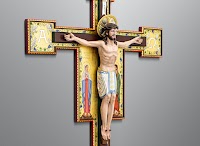 With the subject of the Franciscan shrine at La Verna fresh in mind with our recent considerations of the " tonacella " worn by its novices (seen on the left), I am put to mind of an impressive set of solemn vestments also found at the shrine: The "parato di Pe…
With the subject of the Franciscan shrine at La Verna fresh in mind with our recent considerations of the " tonacella " worn by its novices (seen on the left), I am put to mind of an impressive set of solemn vestments also found at the shrine: The "parato di Pe…
Our Advertising Partners
-
The global pandemic has disrupted the normal celebration of the Holy Week in Spain, where, for a second year, the government has forbidden t...
-
We live in a very visual, image-based culture and, what's more, there is always lots of curiosity around the matter of traditional papal...
-
Above is an image of Pope John XXIII after his death in 1963, dressed in red vestments for burial (the arms on the front of the chasuble app...
-
The mitre is one of the most recognizable symbols of prelates of the Church, specifically of bishops up to the Roman pontiff himself -- thou...
-
The papal blessing known as the Benedictio Coram Populo, or more commonly as the Urbi et Orbi (to the city [of Rome] and to the world) bless...
-
To the person who simply enjoys beautiful art and architecture, distinctions like "baroque" or "rococo" might seem overl...
Blog Archive
-
▼
2021
(258)
-
▼
August
(22)
- The 1574 Pentecost Vestments of the Franciscan Shr...
- Liturgical Curiosities: The Franciscan Tonacella P...
- The Tree of Life - Living Vine Crucifix
- Daniel Rock: Nineteenth Century Ecclesiologist and...
- The Presence of Old Testament Righteous in the Lit...
- Revisiting the Ciborium Magnum
- Fifteenth Century Paraments of the Order of the Go...
- What Sits Beneath S. Agnese in Agone (and Piazza N...
- Notre Dame des Victoires in Quebec City
- Four Generations of Woodcarvers: A Brief History o...
- Cerulean Blue Marian Vestments from Formerly Colon...
- The Silver Altar Dressings of the Huesca Cathedral
- New Traveling Altar Cards by Gammarelli
- Raised Embroidered Chasuble of the Late Fifteenth ...
- The San Juan de los Reyes Antependium (Toledo, ca....
- Canadian Iconographer Frank C. Turner
- The Pre-55 Calendar and Inculturation
- Church of St. Joseph: Oldest Catholic Church in No...
- The Camaldolese Abbey Church of the Holy Trinity i...
- Book Notice: Sant'Onofrio al Gianicolo by J.P. Sonnen
- Prelatial Dress of the Religious Orders: The Trini...
- From the Treasury of Basel - The Reliquary of St. ...
-
▼
August
(22)
Donate
Copyright ©
Liturgical Arts Journal | Powered by Blogger






































